西南印度洋中脊的全扩张速率约14~16mm/yr(Dick et al., 2003),是全球最长的超慢速扩张洋中脊之一。对西南印度洋中脊的调查发现这一区域洋壳厚度很薄但岩石圈地幔较厚(Dick et al., 2003; Bach and Früh-Green, 2010)。有的洋脊段火山岩非常薄甚至缺失,大量出露地幔橄榄岩(Zhou and Dick, 2013)。直到近年,Li et al. (2015)才在西南印度洋中脊50°28′E深约9.5km的下地壳探测到潜在的岩浆房。这些现象反映了超慢速扩张洋中脊岩浆起源深度大、上升到浅部地壳的岩浆量少、岩浆房小的特点。
斜长石斑晶体积分数>10%且占比高于橄榄石的玄武岩被称为斜长石超斑状玄武岩(Plagioclase Ultra-phyric Basalts, PUBs)(Cullen et al., 1989),在汇聚或扩散板块边缘以及热点处均有出露(Karsten et al., 1986; Hekinian and Walker, 1987; Batiza and Niu, 1992; Weinsteiger et al., 2010)。在已经发现的斜长石超斑状玄武岩中,斑晶一般由斜长石、橄榄石和/或单斜辉石(Cullen et al., 1989)构成,斜长石与橄榄石体积分数的比值从1到30不等(O'Hara, 1968; Longhi, 1987; Grove et al., 1992)。作为斜长石超斑状玄武岩中最重要的矿物,斜长石斑晶的An值范围从60至90不等,同一样品中不同的斜长石斑晶也可以有截然不同的结构和成分分带(Hansen and Grönvold, 2000; Cordier et al., 2007; Hellevang and Pedersen, 2008)。前人提出了三种观点解释斜长石超斑状玄武岩成因:斜长石超斑状玄武岩是高Al2O3含量母熔体结晶分异的产物(Panjasawatwong et al., 1995);或者是多种斑晶或俘虏晶的混合产物(Hansen and Grönvold, 2000);也有人认为是斜长石后期聚集的产物(Weinsteiger et al., 2010; Neave et al., 2013; Valer et al., 2017)。Bennett et al. (2019)统计了采自Gakkel洋脊(北冰洋中脊)的玄武岩中(斜长石模态含量大于50%)超过1800个的斜长石晶体,根据其结构和成分,恢复晶体在超慢速扩张洋中脊深部形成过程中的物理、化学环境。本研究对西南印度洋中脊63.9°E采集到的斜长石超斑状玄武岩中斑晶与基质以及不同类型斜长石之间的关系进行了分析,并对比研究了斜长石超斑状玄武岩与同一洋脊段非斑状玄武岩成分之间的关系,探讨西南印度洋中脊63.9°E斜长石超斑状玄武岩的形成过程,揭示超慢速扩张洋中脊深部岩浆过程的特征。
1 地质背景西南印度洋中脊(SWIR)西起南大西洋的布维三联点(Bouvet Triple Junction, BTJ)(54°50′S、00°40′W),东至印度洋的罗德里格斯三联点(Rodrigues Triple Junction, RTJ)(25°30′S、70°00′E)(Font et al., 2007),全长约7700km(Georgen et al., 2001)。西南印度洋中脊是超慢速扩张洋中脊,全扩张速率为14~16mm/yr(Dick et al., 2003),洋脊的西南端,扩张速率稍有增加为16~18mm/yr,至东北端,扩张速率略有降低为12~13mm/yr(Chu and Gordon, 1999)。
西南印度洋中脊的东段(45°~70°E)被两个重要的断裂带即Gallieni断裂带(52°20′E)和Melville断裂带(60°45′E)划分为三个区域,这段洋脊从东到西表现出从构造主导扩张到岩浆主导扩张的变化(Mendel et al., 1997; Cannat et al., 1999),这与自东向西洋脊平均水深减小、轴部的火山数量增多一致(Mendel et al., 1997; Cannat et al., 1999),表明从东向西地壳厚度增加和/或地幔密度减小(Cannat et al., 1999; Sauter et al., 2001)。这些现象可能是因为洋脊轴部的熔体经历了更长期的岩石圈地幔结晶(Lizarralde et al., 2004)或者是自东北到西南,洋脊轴部的岩浆供应量增多(Mendel et al., 1997; Cannat et al., 1999)造成的。
研究区位于Melville断裂带(60°45′E)以东,是西南印度洋中脊东段的三个区域中,平均水深较深(大于4000m)(Mendel et al., 2003)、洋壳厚度最薄、上升到地表的熔体量最少的一段洋脊。样品采集点位于靠近洋脊段中心,水深较浅(2958m)。值得注意的是,Li et al. (2017)和Cipriani et al. (2011)在样品采集点周边远离轴部、水深较深的区域(63.5°E)采集到了橄榄岩(图 1)。
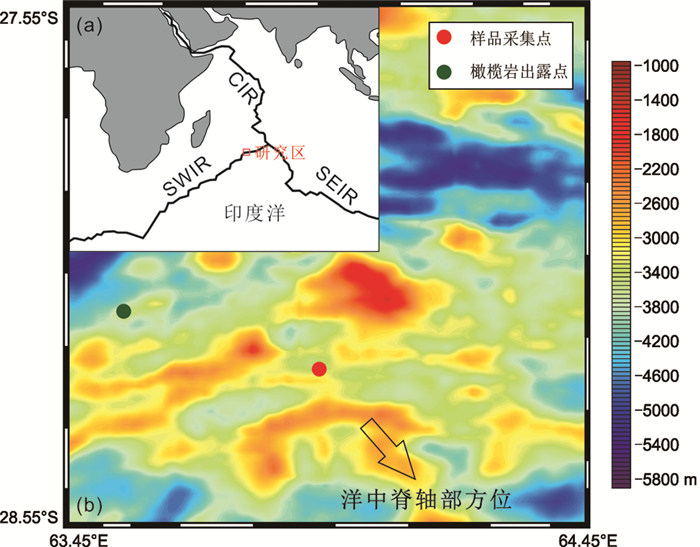
|
图 1 研究区位置(a,据杨阳, 2013修改)和样品采集点地形图(b, 据DY43航次多波束数据作图) CIR-Central Indian Ridge,中印度洋中脊;SWIR-Southwest Indian Ridge,西南印度洋中脊;SEIR-Southeast Indian Ridge,东南印度洋中脊 Fig. 1 Location of study area (a, modified after Yang, 2013) and topographic map of sampling position (b, multibeam data source in DY43 scientific cruise) |
本文研究的玄武岩样品来自于西南印度洋洋中脊东段东北端(63.9°E)的电视抓斗地质取样,共1件。样品为斑状结构,斑晶主要由斜长石和橄榄石组成,主要为斜长石(>95%),粒径从1~5mm不等,仅有少量橄榄石斑晶(< 5%),粒径小于1mm,斜长石与橄榄石的体积比大致为20:1,基质为玄武质玻璃(图 2a)。样品中的斜长石斑晶主要为板状,部分斜长石有环带、筛状、溶蚀现象(图 2b, c)。
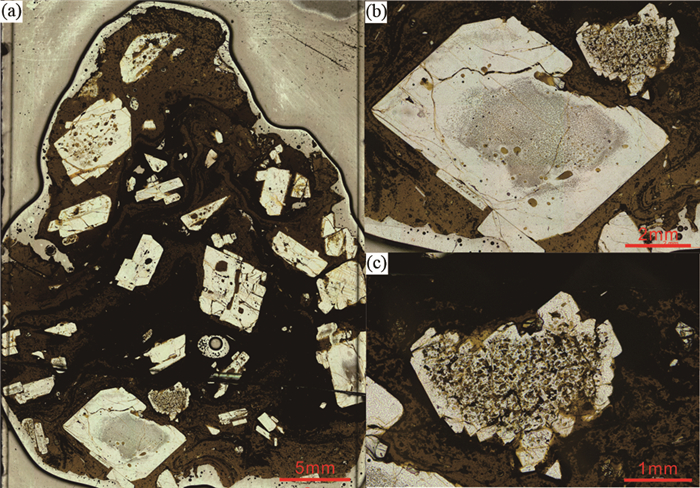
|
图 2 SWIR63.9°E斜长石超斑状玄武岩薄片照片(a)及具有溶蚀结构的斜长石斑晶(b)和具有筛状结构的斜长石斑晶(c) Fig. 2 Photo of thin section (a) and plagioclase phenocryst with resorbed texture (b), plagioclase phenocryst with sieve texture (c) of Plagioclase Ultra-phyric Basalt collected at SWIR63.9°E |
样品全岩的主量元素含量分析在澳实分析测试(广州)有限公司完成。利用PANalytical PW2424 X射线荧光光谱仪(XRF)对全岩常量元素SiO2、TiO2、Al2O3、FeOT、MgO、CaO、Na2O、K2O、MnO2、P2O5、Cr2O3、SO3进行测试。测试过程中采用GBM908-10和MRGeo08作为标准样品,相对误差和相对标准差均小于5%。
橄榄石、斜长石和玻璃的主量元素含量原位分析在同济大学海洋科学技术研究中心完成,仪器型号为JEOL JXA-8230电子探针分析仪。选择薄片中粒径>1mm的斜长石的核部和边缘区域,共计37个;以及粒径 < 0.1mm的斜长石进行分析。分析时间为2min。分析时采用15kV加速电压,10nA探针电子束流,3~5μm的束斑直径,分析时间为2min。标准样品采用SPI国际标准,样品修正方法采用ZAF法,相对标准差低于小于0.05%。
3 测试结果SWIR63.9°E斜长石超斑状玄武岩全岩的SiO2含量为50.77%,CaO含量为11.30%,Na2O含量为3.86%,Al2O3含量为19.31%,MgO含量为5.85%,FeOT含量为7.57%(表 1),其Al2O3含量高于99%的全球洋中脊系统中已经发现的玄武质熔体成分,其中包括洋中脊玄武岩、玻璃以及熔体包裹体(图 3)。
|
|
表 1 SWIR63.9°E洋中脊玄武岩全岩、玻璃基质主量元素分析结果(wt%) Table 1 Contents of major elements in whole rock and glass matrix of Plagioclase Ultra-phyric Basalt collected at SWIR63.9°E (wt%) |
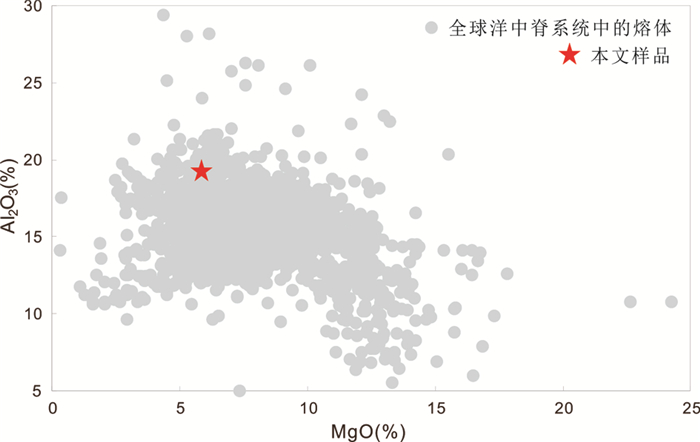
|
图 3 本文样品与全球洋中脊系统的玄武质熔体成分对比全球洋中脊系统中玄武质熔体的数据来源于PetDB: http://www.earthchem.org/petdb Fig. 3 Comparing Al content of the sample with basaltic melts in global ridge system |
通过数点法对样品薄片中各组分的体积分数进行统计,发现斜长石斑晶的体积分数约25%,橄榄石斑晶的体积分数约1%,玻璃基质体积分数约74%。
样品中玻璃基质的SiO2含量为52.05%,CaO含量为10.49%,Na2O含量为3.97%,Al2O3含量为15.78%,MgO含量为6.80%,FeOT含量为7.87%(表 1)。
斜长石斑晶的SiO2含量为50.30%~54.89%;CaO含量为10.16%~14.50%;Na2O含量为2.87%~4.52%;An值范围58.5~72.3(表 2),低于大多数已经发现的斜长石超斑状玄武岩中斜长石斑晶的An值。橄榄石斑晶的SiO2含量为40.11%~40.65%;MgO含量为45.67%~46.84%;FeOT含量为12.59%~13.17%;Fo值范围87.7~87.9(表 2)。
|
|
表 2 SWIR63.9°E洋中脊玄武岩中晶体的主量元素分析结果(wt%) Table 2 Contents of major elements in olivine and plagioclase of Plagioclase Ultra-phyric Basalt collected at SWIR63.9°E (wt%) |
一般认为,斑晶是在熔体上升过程中通过结晶分异作用形成的,如果熔体与在其结晶产生的斑晶一起喷发出地表形成火山岩,那么斑晶与玻璃基质的成分应该是平衡的。
根据元素在熔体和矿物之间的分配系数,可以计算与熔体达到平衡时的矿物成分。取KdOl-LiqMg-Fe=0.3(Ford et al., 1983),计算与玻璃基质成分平衡的橄榄石Fo值,得到与玻璃基质平衡的橄榄石Fo值为74.2±0.4,这与样品中的橄榄石斑晶(Fo 87.7~87.9)相比存在较大的差异,即橄榄石斑晶与玻璃基质之间存在明显的不平衡,因此它们应该来源于不同期次的熔体。利用Namur et al. (2012)的模型计算与玻璃基质成分平衡的斜长石An值,得到的平衡斜长石An值为66.0±0.8。平衡斜长石An值在样品中斜长石的An值(58.5~72.3)范围之内,发现斜长石斑晶发育溶蚀、筛状这种受到后期熔体作用形成的特殊结构(图 2c),说明斜长石斑晶与玻璃基质并非同一期次熔体的产物,这与Bennet et al. (2019)的研究成果相符。
Font et al. (2007)结合Meyzen et al. (2003)的数据,对比了西南印度洋洋中脊东段的玄武岩玻璃基质的主量元素含量,发现该段洋脊中采自同一位置样品的K2O、P2O5含量变化范围较大,据此推测该区域可能受到多期次熔体的作用。这与本文的观点一致。
4.2 SWIR63.9°E斜长石超斑状玄武岩中不同类型斜长石之间的关系利用Rudge (2008)的方法对不同类型斜长石晶体的An值进行核密度估算(Kernel density estimations, KDEs)(图 4),在这一分析中将斜长石分为斑晶(>1mm)核心、斑晶(>1mm)边缘以及微晶(< 100μm)。通过分析中可以发现,斑晶核心An值分布范围较分散(59~72),但斑晶边缘以及微晶的An值呈双峰分布且范围较集中,直观地表现出SWIR63.9°E斜长石超斑状玄武岩中不同类型斜长石之间存在成分差异。

|
图 4 样品中三类斜长石An值的KDEs Fig. 4 Kernel density estimations (KDEs) of plagioclase An in sample |
一般情况下随着岩浆的结晶分异,斜长石从核心到边缘An值连续降低。具有反环带结构的斜长石常见于岛弧岩石中,通常是由于岩浆房内部熔体发生再富集成分改变引起的(Tepley Ⅲ et al., 1999),洋中脊玄武岩中比较少见(Hellevang and Pedersen, 2008)。但是SWIR63.9°E斜长石超斑状玄武岩中的斜长石斑晶出现了类似反环带结构的现象(图 5)。根据斜长石BSE图中不同区域的明暗变化和沿长轴的测线,发现斜长石的边缘和核心周边的区域(BSE图中较浅色区域)An值明显偏高。产生这种现象的原因有两种,一种是熔体成分发生改变,另一种是熔体的减压结晶作用。虽然减压导致结晶产出的斜长石具有较高的An值,但是与早期的结晶的斜长石相比其TiO2含量却不会发生变化(Bennett et al., 2019),这与样品中的实际现象不符,因此可以确定样品中斜长石成分的改变是由熔体成分的变化引起的。
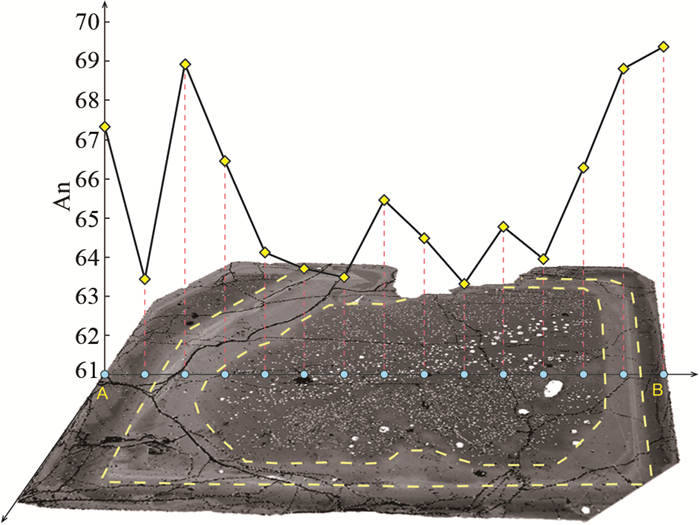
|
图 5 样品中斜长石斑晶BSE图及An值测线 Fig. 5 BSE image and An along the long axis of a phenocryst in sample |
根据两种类型斜长石的分布形态和位置,认为初始斜长石结晶后受到后期熔体作用,其成分发生了改变。与核心区域相比,受后期熔体作用的部位An值偏高,推测早期结晶形成的低An值斜长石可能受到后期高Ca/Na熔体溶蚀作用的影响,成分发生改变。因此样品中斜长石斑晶的结构和成分变化记录了多期次熔体作用。
4.3 SWIR63.9°E斜长石超斑状玄武岩与同一洋脊段MORB成分的一致性SWIR63.9°E斜长石超斑状玄武岩全岩的Al2O3含量高于全球洋中脊系统中已发现的99%的熔体成分(图 3)。Lange et al. (2013)将前人测试过的全球斜长石超斑状玄武岩玻璃基质的主量元素含量,与同一洋脊或构造单元的非斑状玄武岩的主量元素含量进对比,发现两者的范围相似,认为产生两种类型玄武岩的母熔体之间不存在差异。但是以整个洋脊为背景对两种类型的岩石进行对比,可能会因为同一洋脊中不同洋脊段之间玄武岩的成分差异巨大使得玄武岩的主量元素含量的范围过大,掩盖了两者之间真正的差异。本文对此方法进行了改进,即按照已有斜长石超斑状玄武岩的经纬度和水深,选取至少采自相同洋脊段的玄武岩(优先选择玻璃)进行对比。参与对比的所有数据均来自于前人的研究成果,其中北冰洋中脊(Arctic Ridge)的斜长石超斑状玄武岩采自Mohns和Knipovich脊。为了更加直观地展现两种类型玄武岩的成分,利用MgO+FeOT用来对比两者母熔体之间是否存在演化程度或地幔源区的明显差异;由于斜长石超斑状玄武岩中超高的斜长石含量使得全岩成分富Al,因此选择Al2O3+SiO2这两种斜长石中的主要元素来对比两者的母熔体是否存在成分上的差异。根据对比结果(图 6),我们可以发现全球各洋中脊或构造单元的斜长石超斑状玄武岩主量元素含量,几乎都位于同一洋脊段的玄武岩主量元素含量范围以内。尤其是与西南印度洋中脊同属于超慢速扩张洋中脊的北冰洋中脊,样品量较多,两种类型玄武岩的基质成分也表现出很高的相似性。因此认为形成斜长石超斑状玄武岩的熔体,与同一洋脊段玄武岩的母熔体并无成分上的差异,这与Lange et al. (2013)的观点一致。

|
图 6 斜长石超斑状玄武岩基质与非斑状玄武岩成分对比 Galapagos Island-加拉帕戈斯群岛;SEIR-Southeast Indian Ridge,东南印度洋中脊;Gorda Ridge-戈尔达脊;SWIR-Southwest Indian Ridge,西南印度洋中脊;Arctic Ridge-北冰洋中脊.数据来源于:杨阳, 2013; Christie, 2004; Cullen et al., 1989; Hellevang and Pedersen, 2008; Weinsteiger et al., 2010; PetDB: http://www.earthchem.org/petdb Fig. 6 Comparing the composition of PUB's matrix and adjacent aphyric basalts |
SWIR63.9°E斜长石超斑状玄武岩全岩的Al2O3含量高于绝大多数的洋中脊玄武岩及其中的玻璃和熔体包裹体(图 3)。但是其基质成分与同一洋脊段的非斑状玄武岩相似,样品中除斜长石以外缺乏其他富Al的矿物,斜长石斑晶的An值也低于其他洋中脊区域发现的同类样品中斜长石的An值(76~92)(数据来源于Lange et al., 2013)。因此认为SWIR63.9°E斜长石超斑状玄武岩超高的Al2O3含量是高斜长石体积分数的结果,而如此高体积分数的斜长石不可能仅仅是结晶分异作用的产物。与此同时,SWIR63.9°E斜长石超斑状玄武岩中的斑晶种类比较单一,绝大多数为自形程度较高且成分相近的斜长石,其筛状、溶蚀等指示矿物在结晶后受熔体作用的结构广泛发育。所以,高体积分数的斜长石更有可能是斜长石在深部结晶、反应、增生后被熔体带出地表,而不是熔体上升过程中从围岩中捕获而来。由于Gakkel洋脊玄武岩样品中的斜长石模态含量极高(>50%),且没有明确证据能够证明北冰洋中脊下方存在岩浆房,因此Bennett et al. (2019)认为斜长石晶体来自于晶体主导的环境(如晶粥带)。但是,本文样品的晶体含量明显低于Gakkel洋脊玄武岩,且西南印度洋下方存在具有小规模岩浆房的可能,因此本文样品中的斜长石来源于熔体主导环境(如岩脉或岩浆房)(Bennett et al., 2019)。
Neave et al. (2013)认为熔体在从深部运移到岩浆房的过程中,密度的差异可能就已经使得熔体中携带的镁橄榄石与钙质斜长石分离。在Lange and Carmichael (1990)以及Lange (1997)对熔体摩尔体积的研究基础上对熔体密度进行计算,发现与高Fo值橄榄石和高An值斜长石平衡的Haleyjabunga玻璃(Gurenko and Chaussidon, 1995)密度为2.699g/mm3。根据Smyth and McCormick (1995)的数据,Fo值88的橄榄石密度为3.573g/mm3,而An值88的斜长石密度为2.746g/mm3。因此在熔体上升过程中橄榄石就会沉入熔体底部,而斜长石会被上升的熔体带入岩浆房(Neave et al., 2013),只有在熔体上升速度足够快的情况下才会有少量橄榄石斑晶被熔体携带至岩浆房与斜长石发生混合。这与斜长石超斑状玄武岩中,高且不稳定的斜长石/橄榄石比值及两者间成分的不平衡特征相符。Weinsteiger et al. (2010)计算了不同条件下斜长石超斑状玄武岩中斜长石、寄主熔体和熔体包裹体的密度,发现斜长石的密度与其An值呈正相关:An值70的斜长石密度为2.66g/mm3,An值94的斜长石密度为2.71g/mm3。寄主熔体和包裹体的密度随着演化程度的升高而增大,在H2O含量小于0.5%的条件下,寄主熔体的密度为2.69~2.73g/mm3,熔体包裹体的密度为2.69~2.72g/mm3,这意味着钙质斜长石在储存无水岩浆的岩浆房中呈悬浮状态,聚集在岩浆房顶部。因此,SWIR63.9°E低An值(An < 70)的斜长石超斑状玄武岩成因可以归结为各种矿物及熔体间的密度差异:在熔体上升过程中共结晶的斜长石斑晶和橄榄石斑晶由于密度差异发生分离,橄榄石斑晶沉降而斜长石斑晶悬浮于熔体中向上运移到达岩浆房;岩浆房内,斜长石斑晶与熔体之间的密度差使其能够漂浮在熔体上部,并在岩浆房顶部形成斜长石聚集体(图 7)。最终在上升熔体的作用下,斜长石聚集体被携带并喷发出地表形成斜长石超斑状玄武岩。
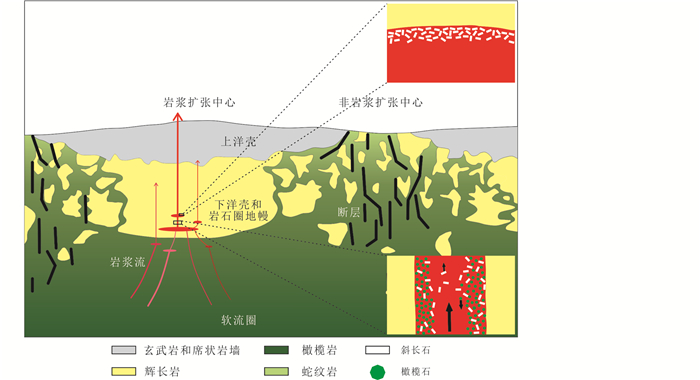
|
图 7 SWIR63.9°E斜长石超斑状玄武岩成因机制模式图(背景图据Cannat et al., 1995) 红色箭头代表斜长石超斑状玄武岩的母熔体,在熔体到达岩浆房之前斜长石和橄榄石可能已经在密度的作用下完成了分选,到达岩浆房后斜长石凭借较熔体小的密度悬在岩浆房顶部漂浮并聚集,最后被喷发的岩浆携带到海底形成斜长石超斑状玄武岩 Fig. 7 Hypothetical model for the occurrence of SWIR63.9°E PUBs (background map after Cannat et al., 2015) Arrow in red represents parent melts of plagioclase ultra-phyric basalts. Because of the difference in density, olivine separat from melts and deposit, plagioclase is carried by melts to magma chamber. Plagioclase float and accumulate at the top of magma chamber because of the less density than melts before eruption |
SWIR63.9°E斜长石超斑状玄武岩的形成也对我们认识超慢速扩张洋中脊深部岩浆过程具有一定的意义。西南印度洋中脊洋中脊作为超慢速扩张洋脊,岩浆扩张中心和非岩浆扩张中心在脊轴上相间出现,岩浆活动呈点状分布。但是超慢速扩张洋中脊周期性供应熔体且数量较少的特点,为斜长石在岩浆房内的聚集提供了足够的时间,也为后期熔体的作用提供了时间。与此同时,虽然西南印度洋洋中脊深部没有较大规模的岩浆房,但是较小规模的岩浆汇聚中心(Li et al., 2015),也为斜长石在深部的聚集提供了充足的空间。斜长石超斑状玄武岩与同一洋脊段玄武岩表现形式的差异和基质成分的一致性证明了超慢速扩张洋中脊深部可能存在多种形式的岩浆过程。
5 结论SWIR63.9°E斜长石超斑状玄武岩虽与同一洋脊段玄武岩的母熔体无成分上的差异。但橄榄石斑晶与基质的不平衡,斜长石斑晶化学成分的多样性及其斑晶中不平衡结构的发育说明这些斑晶并不是单一玄武质熔体结晶分异的产物,而可能是早期结晶的斑晶受随后多期熔体作用的结果。此外,斜长石超斑状玄武岩中超高含量的斜长石斑晶是由于矿物及熔体间存在密度差异,并通过浮力分选在岩浆房顶部聚集的结果。斜长石超斑状玄武岩的出露从侧面反映了西南印度洋中脊作为超慢速扩张洋脊具有熔体供应量少、供应周期长的特点。
Bach W and Früh-Green GL. 2010. Alteration of the oceanic lithosphere and implications for seafloor processes. Elements, 6(3): 173-178 DOI:10.2113/gselements.6.3.173 |
Batiza R and Niu YL. 1992. Petrology and magma chamber processes at the East Pacific Rise~9°30'N. Journal of Geophysical Research:Solid Earth, 97(B5): 6779-6797 DOI:10.1029/92JB00172 |
Bennett EN, Lissenberg CJ and Cashman KV. 2019. The significance of plagioclase textures in mid-ocean ridge basalt (Gakkel Ridge, Arctic Ocean). Contributions to Mineralogy and Petrology, 174(6): 49 DOI:10.1007/s00410-019-1587-1 |
Cannat M, Mevel C, Maia M, Deplus C, Durand C, Gente P, Agrinier P, Belarouchi A, Dubuisson G, Humler E and Reynolds J. 1995. Thin crust, ultramafic exposures, and rugged faulting patterns at the Mid-Atlantic Ridge (22°~24°N). Geology, 23(1): 49-52 DOI:10.1130/0091-7613(1995)023<0049:TCUEAR>2.3.CO;2 |
Cannat M, Rommevaux-Jestin C, Sauter D, Deplus C and Mendel V. 1999. Formation of the axial relief at the very slow spreading Southwest Indian Ridge (49° to 69°E). Journal of Geophysical Research:Solid Earth, 104(B10): 22825-22843 DOI:10.1029/1999JB900195 |
Christie DM. 2004. Submitted data set: Major and trace element composition of basalts from the Galapagos Archipelago, Plume 2 cruise. https://explore.earthchem.org/dataset/2768
|
Chu DZ and Gordon RG. 1999. Evidence for motion between Nubia and Somalia along the Southwest Indian Ridge. Nature, 398(6722): 64-67 DOI:10.1038/18014 |
Cipriani A, Bonatti E and Carlson RW. 2011. Nonchondritic 142Nd in suboceanic mantle peridotites. Geochemistry, Geophysics, Geosystems, 12(3): Q03006 |
Cordier C, Caroff M, Juteau T, Fleutelot, C, Hémond C, Drouin M, Cotten J and Bollinger C. 2007. Bulk-rock geochemistry and plagioclase zoning in lavas exposed along the northern flank of the western Blanco Depression (Northeast Pacific):Insight into open-system magma chamber processes. Lithos, 99(3-4): 289-311 DOI:10.1016/j.lithos.2007.06.009 |
Cullen A, Vicenzi E and McBirney AR. 1989. Plagioclase-ultraphyric basalts of the Galapagos Archipelago. Journal of Volcanology and Geothermal Research, 37(3-4): 325-337 DOI:10.1016/0377-0273(89)90087-5 |
Dick HJB, Lin J and Schouten H. 2003. An ultraslow-spreading class of ocean ridge. Nature, 426(6965): 405-412 DOI:10.1038/nature02128 |
Font L, Murton BJ, Roberts S and Tindle AG. 2007. Variations in melt productivity and melting conditions along SWIR (70°E~49°E):Evidence from olivine-hosted and plagioclase-hosted melt inclusions. Journal of Petrology, 48(8): 1471-1494 DOI:10.1093/petrology/egm026 |
Ford CE, Russell DG, Craven JA and Fisk MR. 1983. Olivine-liquid equilibria:Temperature, pressure and composition dependence of the crystal/liquid cation partition coefficients for Mg, Fe2+, Ca and Mn. Journal of Petrology, 24(3): 256-266 DOI:10.1093/petrology/24.3.256 |
Georgen JE, Lin J and Dick HJB. 2001. Evidence from gravity anomalies for interactions of the Marion and Bouvet hotspots with the Southwest Indian Ridge:Effects of transform offsets. Earth and Planetary Science Letters, 187(3-4): 283-300 DOI:10.1016/S0012-821X(01)00293-X |
Grove TL, Kinzler RJ and Bryan WB. 1992. Fractionation of mid-ocean ridge basalt (MORB). In:Morgan JP, Blackman DK and Sinton JM (eds.). Mantle Flow and Melt Generation at Mid-Ocean Ridges. Washington, DC:American Geophysical Union, 71:281-310
|
Gurenko AA and Chaussidon M. 1995. Enriched and depleted primitive melts included in olivine from Icelandic tholeiites:Origin by continuous melting of a single mantle column. Geochimica et Cosmochimica Acta, 59(14): 2905-2917 DOI:10.1016/0016-7037(95)00184-0 |
Hansen H and Grönvold K. 2000. Plagioclase ultraphyric basalts in Iceland:The mush of the rift. Journal of Volcanology and Geothermal Research, 98(1-4): 1-32 DOI:10.1016/S0377-0273(99)00189-4 |
Hekinian R and Walker D. 1987. Diversity and spatial zonation of volcanic rocks from the East Pacific Rise near 21°N. Contributions to Mineralogy and Petrology, 96(3): 265-280 DOI:10.1007/BF00371248 |
Hellevang B and Pedersen RB. 2008. Magma ascent and crustal accretion at ultraslow-spreading ridges:Constraints from plagioclase ultraphyric basalts from the Arctic mid-ocean ridge. Journal of Petrology, 49(2): 267-294 |
Karsten JL, Hammond SR, Davis EE and Currie RG. 1986. Detailed geomorphology and neotectonics of the Endeavour Segment, Juan de Fuca Ridge:New results from Seabeam swath mapping. Geological Society of America Bulletin, 97(2): 213-221 DOI:10.1130/0016-7606(1986)97<213:DGANOT>2.0.CO;2 |
Lange AE, Nielsen RL, Tepley Ⅲ FJ and Kent AJR. 2013. The petrogenesis of plagioclase-phyric basalts at mid-ocean ridges. Geochemistry, Geophysics, Geosystems, 14(8): 3282-3296 |
Lange RA. 1997. A revised model for the density and thermal expansivity of K2O-Na2O-CaO-MgO-Al2O3-SiO2 liquids from 700 to 1900K:Extension to crustal magmatic temperatures. Contributions to Mineralogy and Petrology, 130(1): 1-11 DOI:10.1007/s004100050345 |
Lange RL and Carmichael ISE. 1990. Thermodynamic properties of silicate liquids with emphasis on density, thermal expansion and compressibility. Reviews in Mineralogy and Geochemistry, 24(1): 25-64 |
Li JB, Jian HC, Chen YJ, Singh SC, Ruan AG, Qiu XL, Zhao MH, Wang XG, Niu XW, Ni JY and Zhang JZ. 2015. Seismic observation of an extremely magmatic accretion at the ultraslow spreading southwest Indian Ridge. Geophysical Research Letters, 42(8): 2656-2663 DOI:10.1002/2014GL062521 |
Li W, Soustelle V, Jin ZM, Li HM, Chen T and Tao CH. 2017. Origins of water content variations in the suboceanic upper mantle:Insight from southwest Indian Ridge abyssal peridotites. Geochemistry, Geophysics, Geosystems, 18(3): 1298-1329 DOI:10.1002/2016GC006767 |
Lizarralde D, Gaherty JB, Collins JA, Hirth G and Kim SD. 2004. Spreading-rate dependence of melt extraction at mid-ocean ridges from mantle seismic refraction data. Nature, 432(7018): 744-747 DOI:10.1038/nature03140 |
Longhi J. 1987. Liquidus equilibria and solid solution in the system CaAl2Si2O8-Mg2 SiO4-CaSiO3-SiO2 at low pressure. American Journal of Science, 287(4): 265-331 DOI:10.2475/ajs.287.4.265 |
Mendel V, Sauter D, Parson L and Vanney JR. 1997. Segmentation and morphotectonic variations along a super slow-spreading center:The Southwest Indian Ridge (57°E~70°E). Marine Geophysical Researches, 19(6): 505-533 DOI:10.1023/A:1004232506333 |
Mendel V, Sauter D, Rommevaux-Jestin C, Patriat P, Lefebvre F and Parson LM. 2003. Magmato-tectonic cyclicity at the ultra-slow spreading southwest Indian Ridge:Evidence from variations of axial volcanic ridge morphology and abyssal hills pattern. Geochemistry, Geophysics, Geosystems, 4(5): 9102 |
Meyzen CM, Toplis MJ, Humler E, Ludden JN and Mével C. 2003. A discontinuity in mantle composition beneath the Southwest Indian ridge. Nature, 421(6924): 731 DOI:10.1038/nature01424 |
Namur O, Charlier B, Toplis MJ and Vander Auwera J. 2012. Prediction of plagioclase-melt equilibria in anhydrous silicate melts at 1-atm. Contributions to Mineralogy and Petrology, 163(1): 133-150 DOI:10.1007/s00410-011-0662-z |
Neave DA, Passmore E, Maclennan J, Fitton G and Thordarson T. 2013. Crystal-melt relationships and the record of deep mixing and crystallization in the ad 1783 Laki Eruption, Iceland. Journal of Petrology, 54(8): 1661-1690 DOI:10.1093/petrology/egt027 |
O'Hara MJ. 1968. The bearing of phase equilibria studies in synthetic and natural systems on the origin and evolution of basic and ultrabasic rocks. Earth-Science Reviews, 4: 69-133 DOI:10.1016/0012-8252(68)90147-5 |
Panjasawatwong Y, Danyushevsky LV, Crawford AJ and Harris KL. 1995. An experimental study of the effects of melt composition on plagioclase-melt equilibria at 5 and 10kbar:Implications for the origin of magmatic high-An plagioclase. Contributions to Mineralogy and Petrology, 118(4): 420-432 DOI:10.1007/s004100050024 |
Rudge JF. 2008. Finding peaks in geochemical distributions:A re-examination of the helium-continental crust correlation. Earth and Planetary Science Letters, 274(1-2): 179-188 DOI:10.1016/j.epsl.2008.07.021 |
Sauter D, Patriat P, Rommevaux-Jestin C, Cannat M, Briais A and Gallieni Shipboard Scientific Party. 2001. The southwest Indian Ridge between 49°15'E and 57°E:Focused accretion and magma redistribution. Earth and Planetary Science Letters, 192(3): 303-317 DOI:10.1016/S0012-821X(01)00455-1 |
Smyth JR and McCormick TC. 1995. Crystallographic data for minerals. In: Ahrens TJ (ed.). Mineral Physics & Crystallography: A Handbook of Physical Constants. Washington, DC: American Geophysical Union, 2: 1-17
|
Tepley Ⅲ FJ, Davidson JP and Clynne MA. 1999. Magmatic interactions as recorded in plagioclase phenocrysts of Chaos Crags, Lassen Volcanic Center, California. Journal of Petrology, 40(5): 787-806 DOI:10.1093/petroj/40.5.787 |
Valer M, Bachèlery P and Schiano P. 2017. The petrogenesis of plagioclase-ultraphyric basalts from La Réunion Island. Journal of Petrology, 58(4): 675-698 DOI:10.1093/petrology/egx030 |
Weinsteiger AB, Kent A, Tepley FJ and Nielsen RL. 2010. Plagioclase Ultra-phyric Basalts (PUBs): Implications for the nature of the plumbing system at ultraslow-spreading ridges. In: AGU Fall Meeting Abstracts. San Francisco: American Geophysical Union
|
Yang Y. 2013. The influence of unique lithosphere structure beneath ultra-slow spreading ridges on the petrogenesis of MORB from the Southwest Indian Ridge. Ph. D. Dissertation. Beijing: University of Chinese Academy of Sciences (in Chinese with English summary)
|
Zhou HY and Dick HJB. 2013. Thin crust as evidence for depleted mantle supporting the Marion Rise. Nature, 494(7436): 195-200 DOI:10.1038/nature11842 |
杨阳. 2013.西南印度洋MORB的岩石成因研究: 对超慢速扩张洋脊岩石圈结构的响应.博士学位论文.北京: 中国科学院大学
|
 2019, Vol. 35
2019, Vol. 35


